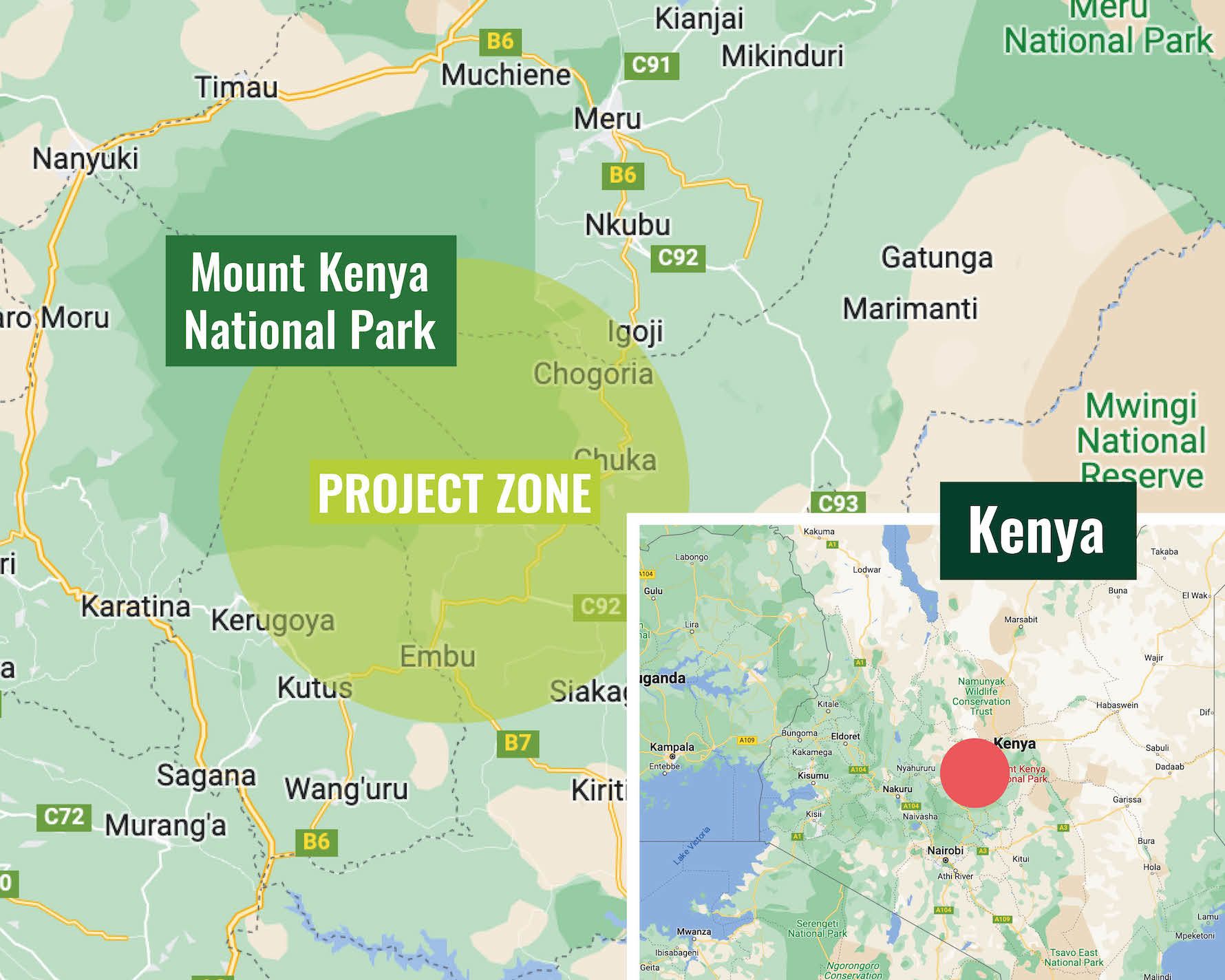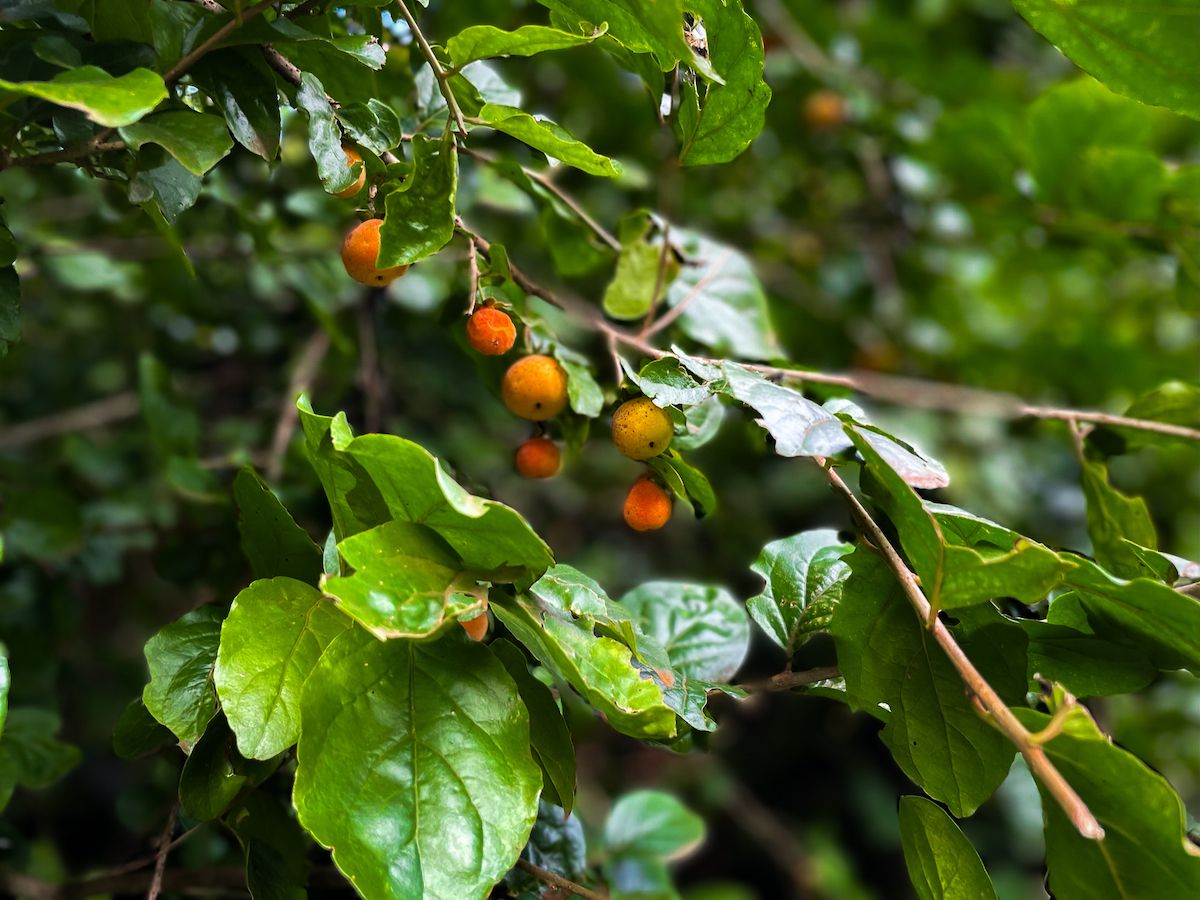In the heart of Mount Kenya National Park, a UNESCO World Heritage site since 1997, the third season of the project developed by Reforest'Action, and supported by Maison Hennessy for the past two years, was completed at the end of 2022. Hennessy has been a partner of Reforest'Action since 2020, funding numerous local initiatives over the long term. Through its multidimensional scope, this project aimed at restoring forest and agricultural ecosystems in Kenya is a concrete illustration of our shared regenerative, impact-oriented approach. Thanks to two waves of planting, in spring and autumn, the year 2022 made it possible to plant 250,000 trees on 500 hectares of land divided between the project's various activities.

In recent years, drought has hit East Africa particularly hard, including Kenya: rainfall has been below average for five consecutive rainy seasons. By January 2023, it was estimated that more than 20 million people were facing acute food insecurity in the region, mainly as a result of drought*. In this rapidly changing socio-climatic context, the project led by the local association Trees for Kenya focuses on restoring Mount Kenya's natural ecosystem and improving the food security of the people who live in this area.
*World Meteorological Organization (WMO), State of the Global Climate report, 2022.
The project's objectives: a three-fold approach
The plots targeted by the project's third season are located in three counties in eastern Kenya: Kirinyaga, Embu and Tharaka Nithi. The typology of ecosystems covered and the actions implemented vary according to altitude, rainfall regime and soil quality. In the highlands, the project is helping to restore the forest of Mount Kenya National Park, which is essential to the proper functioning of the water cycle. Downstream, in the middle and lowlands cultivated with tea and coffee plantations, the creation of agroforestry garden forests aims to support the socio-economic development of farming communities. In addition to forestry work, the project also raises awareness among farming communities about the many benefits of planting trees on their land. Thirdly, by distributing trees to schools in the area, the project includes an educational dimension designed to involve the younger generation. Let's take a look at the progress made by this multi-faceted project.

Mount Kenya forest restoration: promoting the regeneration of a crucial ecosystem
The first part of the project involves reforesting 60 hectares of degraded forest land which, although protected, is unable to regenerate on its own. More than 300,000 people - including members of the Masai and Kikuyu ethnic groups - depend on the Mount Kenya forest for their daily livelihoods: it provides them with water, fruits, and medicinal plants. As a result of deforestation for agriculture and charcoal production, the drastic reduction in the region's forest cover has led to a change in local weather patterns, with rainfall becoming more irregular and scarcer, causing the rivers originating from Mount Kenya to dry up and no longer flow sufficiently to irrigate crops.
Achievements: 65,000 trees planted in the Njukiini forest
In 2022, the project enabled the creation of three conservation sites in the Njukiini forest. The latter lies at the foot of Mount Kenya, between a dried-out wetland and a forest managed by the Kenya Forest Service for commercial purposes. The selected sites are made up of a few scattered trees and therefore have regeneration potential. Work began with the clearing of Lantana Camara, an invasive shrub species that was preventing native vegetation from developing and drawing on the water table, followed by the planting of a diverse range of native species, including Prunus Africana and Podocarpus. A total of 65,000 trees were planted, with the aim of restoring the degraded forest and initiating its future regeneration.
The forestry work was carried out by the Community Conservation Association (CFA), a group of 50 casual workers from local communities, mostly young people and about half of them being women. More broadly, local people are involved in all restoration processes: they participate in the production of seedlings in twelve community nurseries set up as part of the project, as well as in soil preparation through the removal of brush and invasive species, and in the long-term maintenance of the planted trees.



At the end of 2022, Reforest'Action's field audit made it possible to assess the survival rate of the trees planted on the three conservation sites during the previous spring. Despite very limited water resources due to chronic drought, the shade provided by the existing trees and the high moisture level of the forest soil ensured the survival of 74% of the planted trees.
Expected impacts: increased water resources and biodiversity
The porosity created by the organic activity of the forest soil will reduce water runoff, encourage its infiltration into the soil and enable groundwater to be recharged. As a cornerstone of the water cycle, the forest will also help regulate the local climate, increasing the frequency of rainfall and, ultimately, the volume of water flowing into the surrounding rivers. In the long term, restored forests will therefore play an important role in the water resources available to the farming population. Let's not forget that 75%* of the world's fresh water for human and environmental needs comes from forest and mountain ecosystems. At the same time, biodiversity will increase as the forest grows, being home to elephants, monkeys, buffalo, and gazelles’ populations.
*FAO, IUFRO and USDA. 2022. A guide to forest-water management. FAO Forestry Paper No. 185. Rome.
Garden forests: improving food security among farming communities
The second part of the project aims to install agroforestry systems within the tea, coffee, macadamia, maize, bean, sweet potato and banana crops that cover the lower slopes of Mount Kenya. Most farmers in the region own one or two hectares of land at most, and use 75% of it for cash crop production. Almost all households keep livestock or goats on the remaining 25%, on which the family home is also located. While for 98% of them, agriculture is the sole source of income, local farmers are facing sharply reduced crop yields as a result of severe drought.
Achievements: 165,000 trees planted on 434 farmers' land
In 2022, more than 430 new beneficiaries were given trees. They were recruited by a "leading farmers" team made up of local farmers who act as a link between Trees for Kenya's and the farming communities. Agroforestry species such as calliandra, markhamia and pink cedar were planted as hedges around the crops, meanwhile fruit trees were spread throughout the plots. Fruit trees are particularly valuable to farmers, as they will produce avocados, tree tomatoes, mangoes and oranges. Between January and December 2022, 165,000 trees were planted to create garden forests in the low and midlands of Mount Kenya.
Before each wave of planting, training and awareness-raising sessions were organized for farmers, including demonstrations of how to use the planting and monitoring equipment (spades, secateurs, tape and calipers to measure tree height and diameter, etc.). Beneficiaries were also trained in the manufacturing of plant-based organic fertilizers and pesticides, and made aware of the importance of conserving trees on their plots.


The survival rate of trees planted in agroforestry in the spring of 2022 was evaluated at 65% by the end-of-year audit. The main challenge here relates to the lack of available water to irrigate the planted trees, causing them to dry out. It should be noted that trees affected by drought are systematically replaced during the next planting. A new field audit will be conducted by the beginning of 2024 in order to monitor the second wave of plantings that took place in autumn 2022.
During the audit, the testimonies of several beneficiaries were collected. All interviewees seemed now aware of the challenges raised by climate change and the importance of forest ecosystems. They thanked the support provided by the project, without which they would not have had the resources required to plant trees. Some of them revealed that the project not only helped them financially, but also socially, by enabling them to emerge from isolation.
Expected impacts: strengthened food security for communities
The primary objective of agroforestry development on Mount Kenya is to protect and sustain the crops grown by local populations. Trees will provide shade for understorey plantations while acting as windbreaks, thus combating wind erosion. In addition, trees will have numerous benefits for degraded agricultural soils: they will promote nitrogen fixation and the restitution of organic matter through the creation of litter. It has been proven that farmers implementing agroforestry practices in East Africa have seen their yields increase by 100% compared to farmers using non-regenerative practices*. In the longer term, the return of rivers and rainfall, made possible by the restoration of Mount Kenya's forests, will facilitate crop irrigation and fertility.
From an economic point of view, the planted trees will be a source of fodder for livestock, of natural fertilizer for crops and of firewood for the local population. Through their sustainable management, they will thus prevent the harvesting of trees in the still intact primary forest. Furthermore, the fruit trees will help to boost the local population's livelihoods and to generate additional income through the sale of the fruits. Tea and coffee produced in shaded agroforestry systems, considered to be of better quality, will open the way to a new and more marketable value chain. Finally, awareness-raising sessions for farmers help prevent future deforestation while promoting the need to include and preserve trees as an integral component of their agriculture.
*Africa Regenerative Agriculture Study Group, Regenerative Agriculture: An opportunity for businesses and society to restore degraded land in Africa, 2021.

Through its Forest Destination program, Maison Hennessy is committed to promoting the regeneration of 50,000 hectares of forest in France and around the world by 2030, as a means of protecting biodiversity, enhancing the water cycle and responding to the climate emergency. This holistic project developed on the lands of Mount Kenya bears witness to the strong ambition shared by Reforest'Action and Hennessy: to preserve and restore forest ecosystems on a large scale.